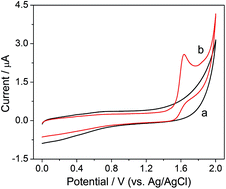Electroanalytical application of a boron-doped diamond electrode for sensitive voltammetric determination of theophylline in pharmaceutical dosages and human urine†
Abstract
In this paper, a novel voltammetric method for the determination of 1,3-dimethylxanthine alkaloid theophylline is elaborated using differential pulse (DPV) and square-wave voltammetric (SWV) modes on a boron-doped diamond electrode. Direct oxidation of the analyte at very positive potentials was observed by cyclic voltammetry, as evidenced by the presence of a well-shaped irreversible peak at +1.63 V (vs. Ag/AgCl electrode) in 1 mol L−1 sulphuric acid. After optimization of experimental conditions, the current response of theophylline was proportionally linear from 2 to 380 μmol L−1 using both pulse techniques. The developed electroanalytical method yielded low detection limits of 0.91 and 1.45 μmol L−1 associated with good intra-day repeatability (relative standard deviation of 3.2 and 2.5%) using DPV and SWV, respectively. The influence of some possible interferents was also evaluated. The practical feasibility of the proposed methodology was tested in the analysis of pharmaceutical dosages and human urine samples and good recovery values were accomplished (93.2–102.5%). The results of analysis of pharmaceuticals were also in close agreement at a 95% confidence level with those obtained using the titration (reference) method. Taking these attributes into consideration, the proposed sensor may be employed as a simple and effective analytical tool in drug control analysis and analysis of biological samples as well as a useful alternative to previously utilized modified electrodes in this field.


 Please wait while we load your content...
Please wait while we load your content...